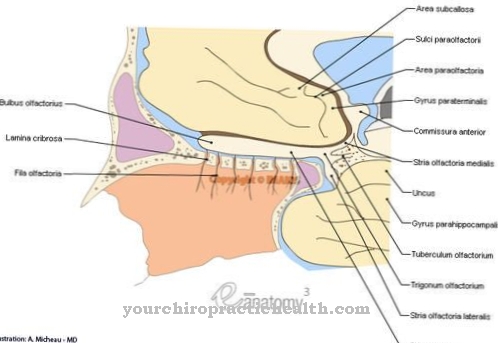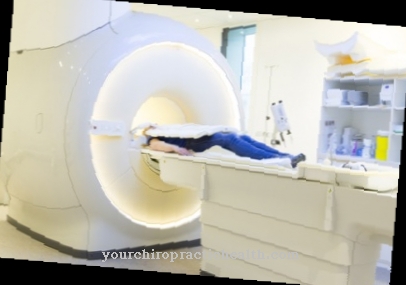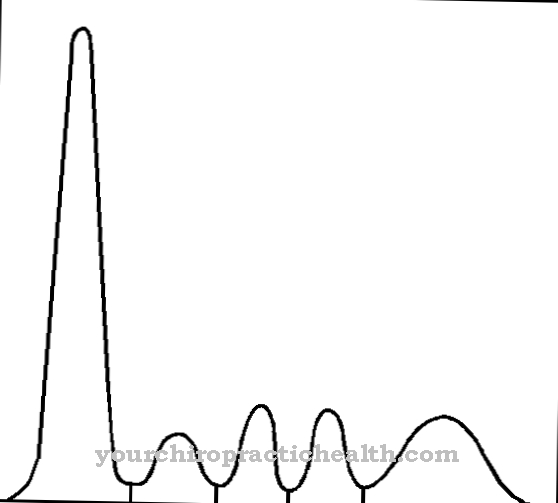The functional magnetic resonance imaging (fMRI) is a method of magnetic resonance tomography for the visual representation of physiological changes in the body. It is based on the physical principles of nuclear magnetic resonance. In the narrower sense, the term is used in connection with the examination of activated areas of the brain.
What is functional magnetic resonance imaging?

On the basis of magnetic resonance tomography (MRT), the physicist Kenneth Kwong developed functional magnetic resonance tomography (fMRI) to visualize changes in activity in the different brain areas. This method measures changes in the cerebral blood flow that are linked to changes in activity in the corresponding areas of the brain via the neurovascular coupling.
This method uses the different chemical environment of the measured hydrogen nuclei in the hemoglobin of oxygen-poor and oxygen-rich blood. Oxygenated hemoglobin (oxyhemoglobin) is diamagnetic, while oxygen-free hemoglobin (deoxyhemoglobin) has paramagnetic properties. The differences in the magnetic properties of the blood are also referred to as the BOLD effect (Blood Oxygenation Level Dependent Effect). The functional processes in the brain are recorded in the form of a series of sectional images.
In this way, the changes in activity in the individual brain areas can be examined using specific tasks on the test subject. This method is initially used for basic research to compare activity patterns in healthy control persons with the brain activities of persons with mental disorders. In a broader sense, the term functional magnetic resonance tomography also includes kinematic magnetic resonance tomography, which describes the moving representation of various organs.
Function, effect & goals
Functional magnetic resonance imaging is a further development of magnetic resonance imaging (MRT). With classic MRI, static images of corresponding organs and tissues are displayed, while fMRI shows changes in activity in the brain through three-dimensional images when certain activities are carried out.
With the help of this non-invasive procedure, the brain can be observed in different situations. As with classic MRI, the physical basis of the measurement is initially based on nuclear magnetic resonance. By applying a static magnetic field, the spins of the protons of the hemoglobin are aligned longitudinally. A high-frequency alternating field applied transversely to this direction of magnetization ensures the transverse deflection of the magnetization to the static field up to resonance (Lamor frequency). If the high-frequency field is switched off, it takes a certain time while releasing energy until the magnetization aligns itself again along the static field.
This relaxation time is measured. In fMRI, the fact that deoxyhemoglobin and oxyhemoglobin are magnetized differently is exploited. This results in different measured values for both forms, which can be attributed to the influence of oxygen. However, since the ratio of oxyhemoglobin to deoxyhemoglobin is constantly changing during the physiological processes in the brain, serial recordings are carried out as part of the fMRI, which records the changes at any point in time. In this way, nerve cell activities can be displayed with millimeter precision in a time window of a few seconds. The location of the neural activity is determined experimentally by measuring the magnetic resonance signal at two different points in time.
First, the measurement takes place in the resting state and then in an excited state. Then the comparison of the recordings is carried out in a statistical test procedure and the statistically significant differences are spatially assigned. For experimental purposes, the stimulus can be presented to the test person several times. This usually means that a task is repeated many times. The differences from the comparison of the data from the stimulus phase with the measurement results from the rest phase are calculated and then represented graphically. With this procedure it was possible to determine which areas of the brain are active in which activity. In addition, the differences between certain brain areas in psychological diseases and healthy brains could be determined.
In addition to basic research, which provides important insights into the diagnosis of psychological diseases, the method is also used directly in clinical practice. The main clinical area of application of fMRI is the localization of language-relevant brain areas in the preparation of operations on brain tumors. This is to ensure that this area is largely spared during the operation. Other clinical areas of application of functional magnetic resonance imaging relate to the assessment of patients with impaired consciousness, such as coma, vegetative state or MCS (minimal state of consciousness).
Risks, side effects & dangers
Despite the great success of functional magnetic resonance tomography, this method should also be viewed critically in terms of its informative value. It was possible to determine essential connections between certain activities and the activation of the corresponding brain areas. The importance of certain areas of the brain for psychological illnesses has also become clearer.
However, only the changes in the oxygen concentration of the hemoglobin are measured here. Because these processes can be localized to certain areas of the brain, it is assumed, based on the neurovascular coupling, that these areas of the brain are also activated. So the brain cannot be observed directly while thinking. It must be noted that the change in blood flow occurs only after a latency period of a few seconds after the neural activity. Therefore, a direct assignment is sometimes difficult. The advantage of fMRI over other non-invasive neurological examination methods is the much better spatial localization of the activities.
However, the temporal resolution is much lower. The indirect determination of neuronal activities through blood flow measurements and hemoglobin oxygenation also creates a certain uncertainty. A latency period of over four seconds is assumed. It remains to be investigated whether reliable neural activities can be assumed with shorter stimuli. However, there are also technical application limits of functional magnetic resonance tomography, which are based, among other things, on the fact that the BOLD effect is not only generated by the blood vessels, but also by the cell tissue adjacent to the vessels.















.jpg)




.jpg)







